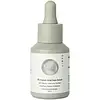What's inside
What's inside
 Key Ingredients
Key Ingredients

 Benefits
Benefits

 Concerns
Concerns

No concerns
 Ingredients Side-by-side
Ingredients Side-by-side

Water
Skin ConditioningPropanediol
SolventAzelaic Acid
Buffering1,2-Hexanediol
Skin ConditioningEthoxydiglycol
HumectantGlycerin
HumectantSodium Hydroxide
BufferingSalicylic Acid
MaskingMandelic Acid
AntimicrobialBifida Ferment Lysate
Skin ConditioningCapryloyl Glycine
CleansingSarcosine
Skin ConditioningCinnamomum Zeylanicum Bark Extract
AntimicrobialCamellia Sinensis Leaf Extract
AntimicrobialPotassium Sorbate
PreservativeSodium Benzoate
MaskingGluconolactone
Skin ConditioningBetaine
HumectantInulin
Skin ConditioningSodium Hyaluronate
HumectantWater, Propanediol, Azelaic Acid, 1,2-Hexanediol, Ethoxydiglycol, Glycerin, Sodium Hydroxide, Salicylic Acid, Mandelic Acid, Bifida Ferment Lysate, Capryloyl Glycine, Sarcosine, Cinnamomum Zeylanicum Bark Extract, Camellia Sinensis Leaf Extract, Potassium Sorbate, Sodium Benzoate, Gluconolactone, Betaine, Inulin, Sodium Hyaluronate
Water
Skin ConditioningAzelaic Acid
BufferingPropanediol
SolventNiacinamide
SmoothingDimethyl Isosorbide
SolventTranexamic Acid
AstringentBetaine
HumectantAlpha-Arbutin
AntioxidantPanthenol
Skin ConditioningPhenethyl Alcohol
MaskingCaprylyl Glycol
EmollientGlycerin
HumectantSodium PCA
Humectant4-Butylresorcinol
AntioxidantFerulic Acid
AntimicrobialTerminalia Ferdinandiana Fruit Extract
AntioxidantAllantoin
Skin ConditioningSodium Hyaluronate
HumectantXanthan Gum
EmulsifyingSodium Hydroxide
BufferingDisodium EDTA
Water, Azelaic Acid, Propanediol, Niacinamide, Dimethyl Isosorbide, Tranexamic Acid, Betaine, Alpha-Arbutin, Panthenol, Phenethyl Alcohol, Caprylyl Glycol, Glycerin, Sodium PCA, 4-Butylresorcinol, Ferulic Acid, Terminalia Ferdinandiana Fruit Extract, Allantoin, Sodium Hyaluronate, Xanthan Gum, Sodium Hydroxide, Disodium EDTA
Ingredients Explained
These ingredients are found in both products.
Ingredients higher up in an ingredient list are typically present in a larger amount.
Azelaic acid is a multitasker ingredient that helps treat acne, pigmentation, and irritation. It is a great option for sensitive skin.
What makes azelaic special?
The best thing about azelaic acid is it's gentleness. It's generally well-tolerated and safe to use alongside other actives like niacinamide or salicylic acid.
Unlike AHAs, azelaic acid will not make you photosensitive/sun sensitive.
You can find this ingredient naturally occurring in grains like wheat, rye, and barley. In cosmetics, azelaic acid is typically lab-made, which is more stable and effective.
Learn more about Azelaic AcidBetaine is a common humectant (a substance that promotes retention of moisture). It's known to be gentle on the skin and can help balance hydration.
This ingredient is best for improving hydration and soothing irritated skin. Studies also show it helps even out skin tone.
Fun fact: Betaine is naturally created in the skin and body. The kind found within cosmetic products can be either plant-derived or synthetic.
Another name for betaine is trimethylglycine.
Learn more about BetaineGlycerin is already naturally found in your skin. It helps moisturize and protect your skin.
A study from 2016 found glycerin to be more effective as a humectant than AHAs and hyaluronic acid.
As a humectant, it helps the skin stay hydrated by pulling moisture to your skin. The low molecular weight of glycerin allows it to pull moisture into the deeper layers of your skin.
Hydrated skin improves your skin barrier; Your skin barrier helps protect against irritants and bacteria.
Glycerin has also been found to have antimicrobial and antiviral properties. Due to these properties, glycerin is often used in wound and burn treatments.
In cosmetics, glycerin is usually derived from plants such as soybean or palm. However, it can also be sourced from animals, such as tallow or animal fat.
This ingredient is organic, colorless, odorless, and non-toxic.
Glycerin is the name for this ingredient in American English. British English uses Glycerol/Glycerine.
Learn more about GlycerinPropanediol is an all-star ingredient. It softens, hydrates, and smooths the skin.
It’s often used to:
Propanediol is not likely to cause sensitivity and considered safe to use. It is derived from corn or petroleum with a clear color and no scent.
Learn more about PropanediolSodium Hyaluronate is hyaluronic acid's salt form. It is commonly derived from the sodium salt of hyaluronic acid.
Like hyaluronic acid, it is great at holding water and acts as a humectant. This makes it a great skin hydrating ingredient.
Sodium Hyaluronate is naturally occurring in our bodies and is mostly found in eye fluid and joints.
These are some other common types of Hyaluronic Acid:
Learn more about Sodium HyaluronateSodium Hydroxide is also known as lye or caustic soda. It is used to adjust the pH of products; many ingredients require a specific pH to be effective.
In small amounts, sodium hydroxide is considered safe to use. However, large amounts may cause chemical burns due to its high alkaline.
Your skin has a natural pH and acid mantle. This acid mantle helps prevent harmful bacteria from breaking through. The acid mantle also helps keep your skin hydrated.
"Alkaline" refers to a high pH level. A low pH level would be considered acidic.
Learn more about Sodium HydroxideWater. It's the most common cosmetic ingredient of all. You'll usually see it at the top of ingredient lists, meaning that it makes up the largest part of the product.
So why is it so popular? Water most often acts as a solvent - this means that it helps dissolve other ingredients into the formulation.
You'll also recognize water as that liquid we all need to stay alive. If you see this, drink a glass of water. Stay hydrated!
Learn more about Water